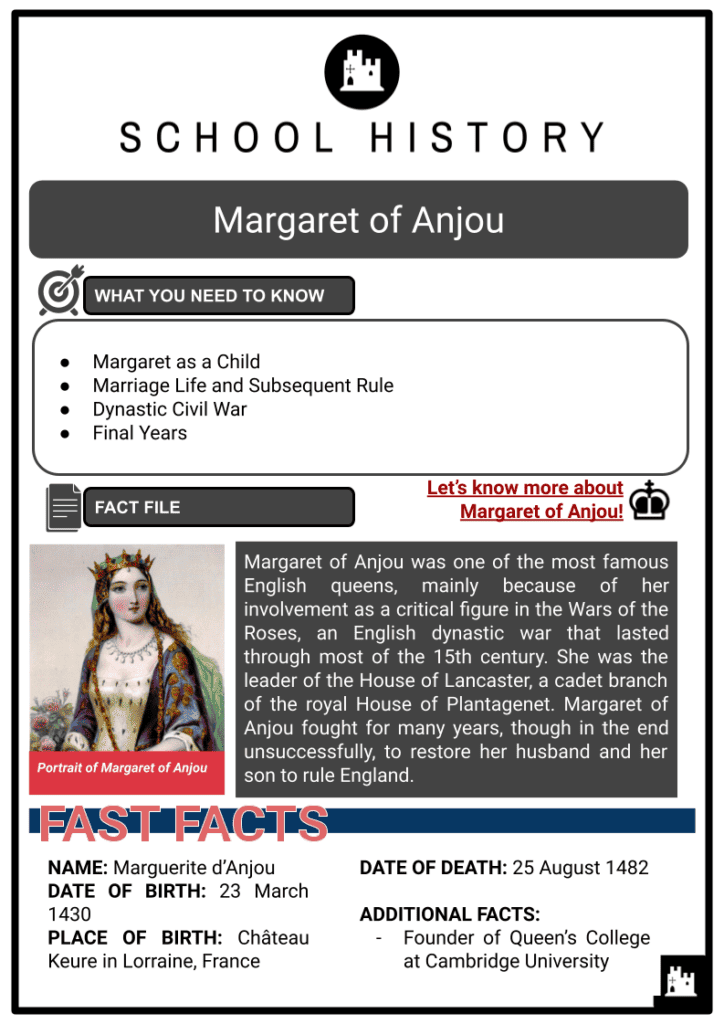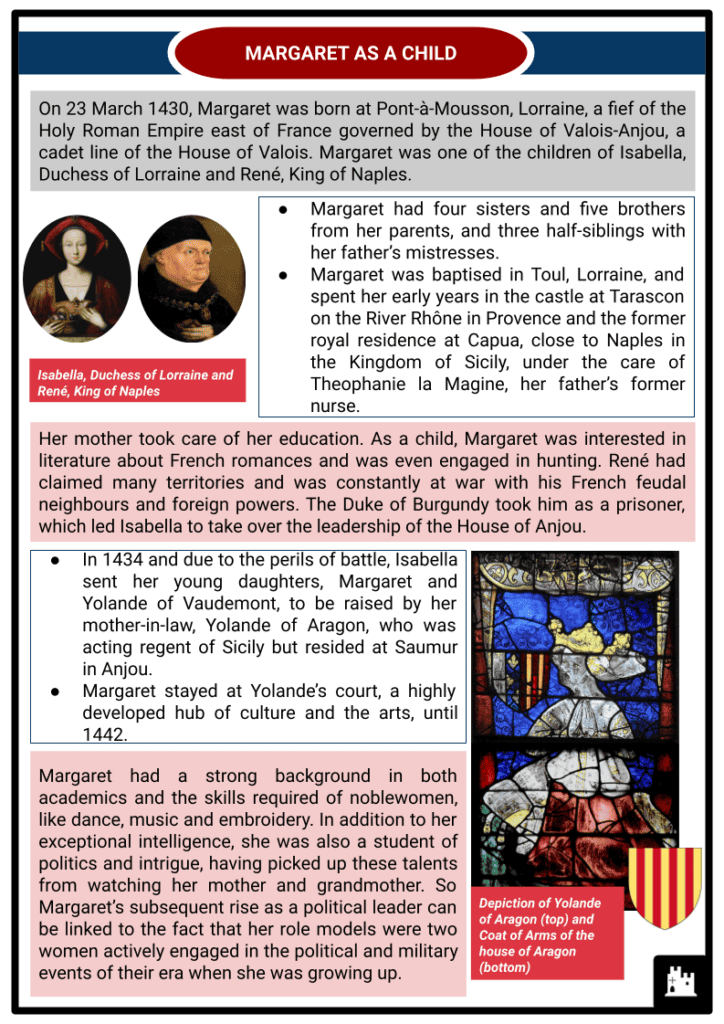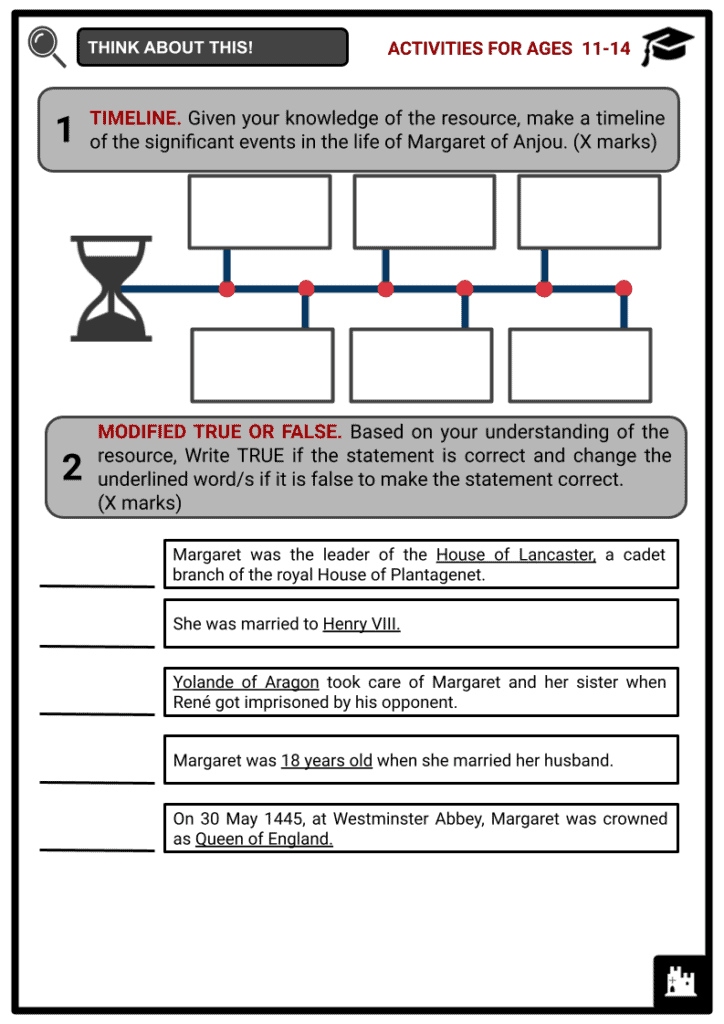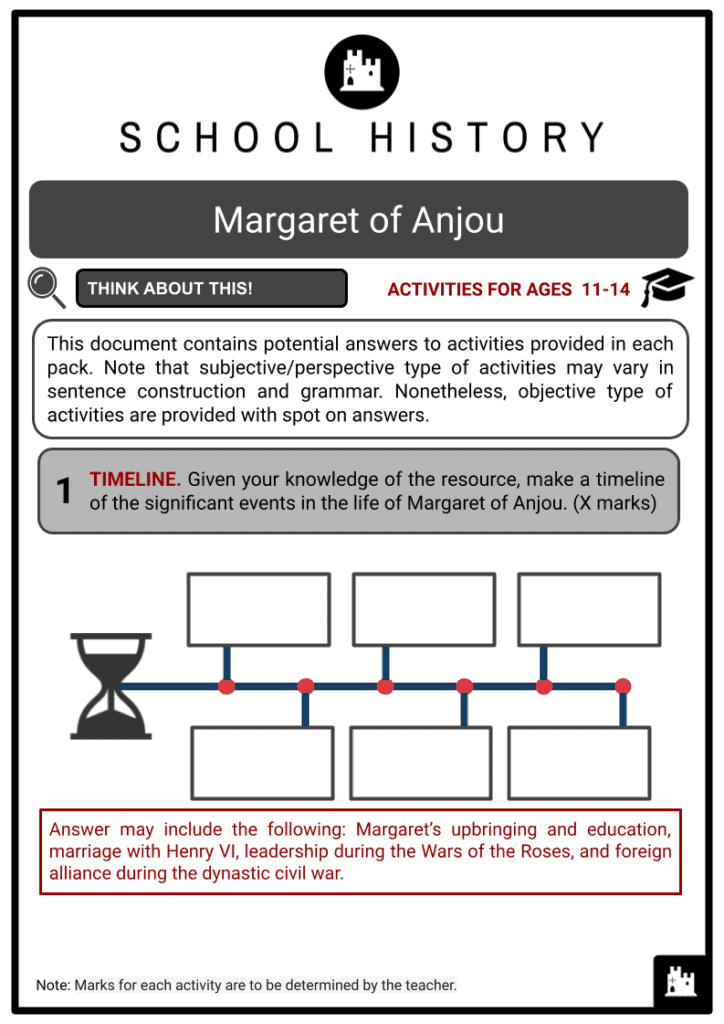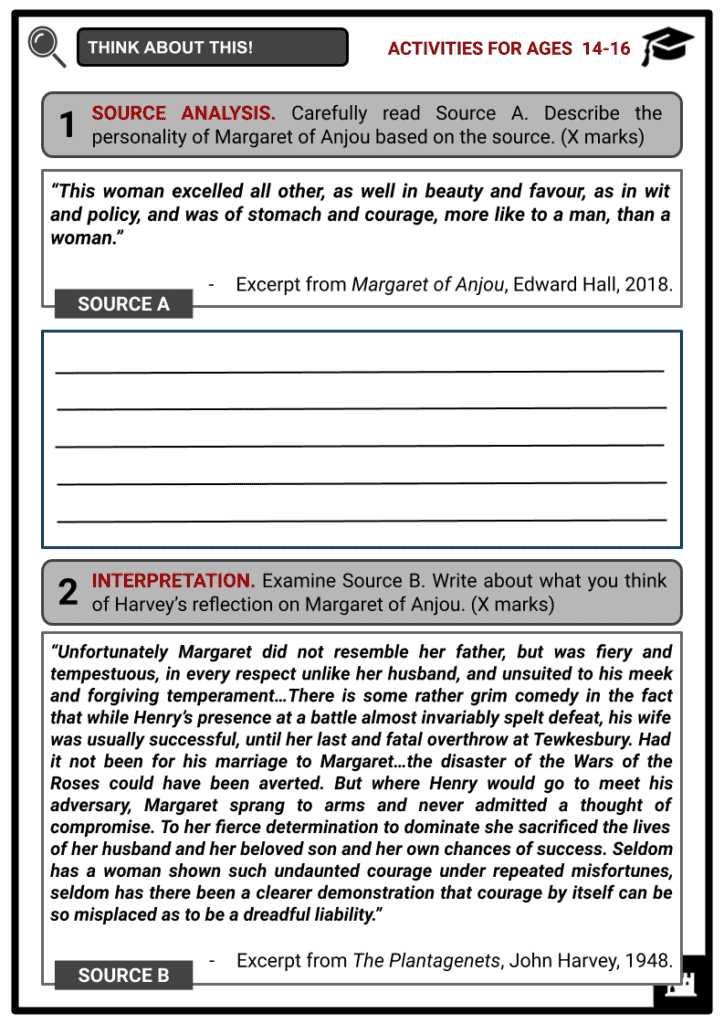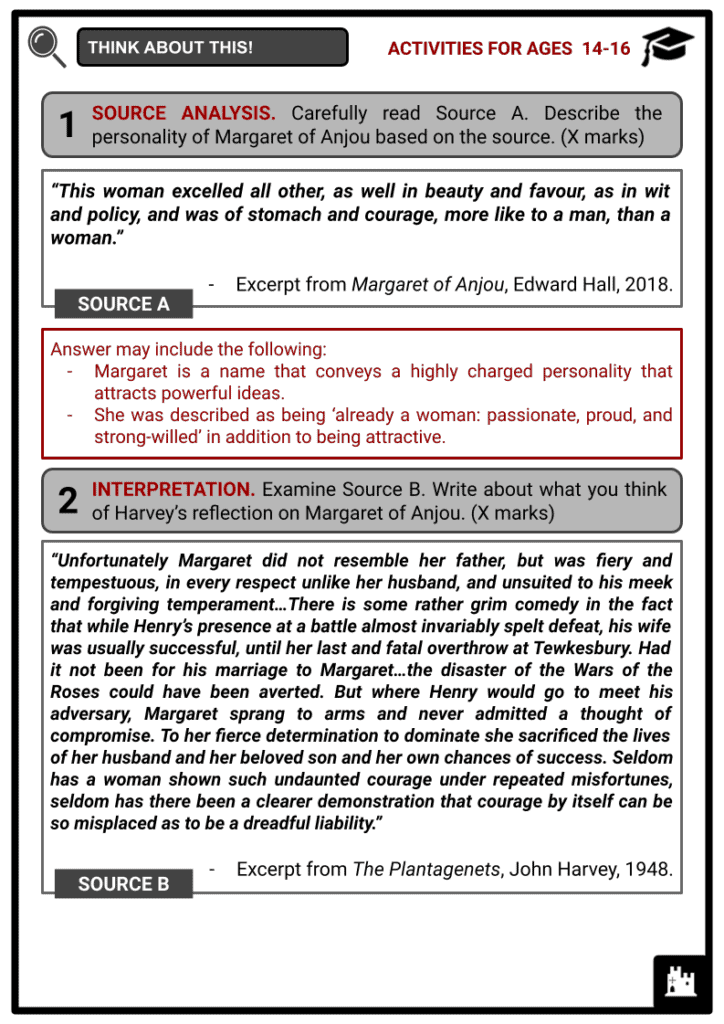Margaret of Anjou Worksheets
Do you want to save dozens of hours in time? Get your evenings and weekends back? Be able to teach about Margaret of Anjou to your students?
Our worksheet bundle includes a fact file and printable worksheets and student activities. Perfect for both the classroom and homeschooling!
Summary
- Margaret as a Child
- Marriage Life and Subsequent Rule
- Dynastic Civil War
- Final Years
Key Facts And Information
Let’s know more about Margaret of Anjou!
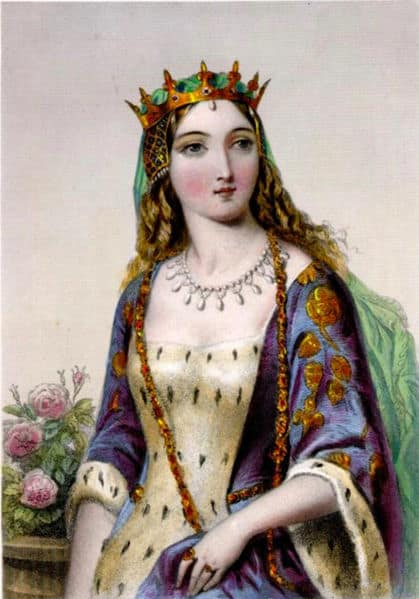
Margaret of Anjou was one of the most famous English queens, mainly because of her involvement as a critical figure in the Wars of the Roses, an English dynastic war that lasted through most of the 15th century. She was the leader of the House of Lancaster, a cadet branch of the royal House of Plantagenet. Margaret of Anjou fought for many years, though in the end unsuccessfully, to restore her husband and her son to rule England.
MARGARET AS A CHILD
- On 23 March 1430, Margaret was born at Pont-à-Mousson, Lorraine, a fief of the Holy Roman Empire east of France governed by the House of Valois-Anjou, a cadet line of the House of Valois. Margaret was one of the children of Isabella, Duchess of Lorraine and René, King of Naples.
- Margaret had four sisters and five brothers from her parents, and three half-siblings with her father’s mistresses.
- Margaret was baptised in Toul, Lorraine, and spent her early years in the castle at Tarascon on the River Rhône in Provence and the former royal residence at Capua, close to Naples in the Kingdom of Sicily, under the care of Theophanie la Magine, her father’s former nurse.
- Her mother took care of her education. As a child, Margaret was interested in literature about French romances and was even engaged in hunting. René had claimed many territories and was constantly at war with his French feudal neighbours and foreign powers. The Duke of Burgundy took him as a prisoner, which led Isabella to take over the leadership of the House of Anjou.
- In 1434 and due to the perils of battle, Isabella sent her young daughters, Margaret and Yolande of Vaudemont, to be raised by her mother-in-law, Yolande of Aragon, who was acting regent of Sicily but resided at Saumur in Anjou.
- Margaret stayed at Yolande’s court, a highly developed hub of culture and the arts, until 1442.
- Margaret had a strong background in both academics and the skills required of noblewomen, like dance, music and embroidery. In addition to her exceptional intelligence, she was also a student of politics and intrigue, having picked up these talents from watching her mother and grandmother. So Margaret’s subsequent rise as a political leader can be linked to the fact that her role models were two women actively engaged in the political and military events of their era when she was growing up.
- After Margaret of Anjou’s father was released from jail in 1442, she returned to live with her parents.
- The Hundred Years’ War, a series of battles between France and England, ended during Margaret’s formative years.
- According to different historical sources, this familial example may have given Margaret the guidelines for her later decisions as her son’s regent.
- In contrast to Western Europe, which had differing attitudes about women wielding authority, England at the time was more hostile.
MARRIAGE LIFE AND SUBSEQUENT RULE
- As part of a peace agreement between England and France in 1444, King Henry VI of England proposed to wed Margaret. Meanwhile, Duke René had grown weary of fighting and had shown little interest in making any more claims to the throne.
- Despite being 15 years old and past the typical marriage age for ladies of her level, Margaret had not been married or engaged.
- Before 1444, there had been numerous attempts to negotiate her marriage, but none succeeded because of the feudal houses’ ongoing hostilities and shifting allegiances.
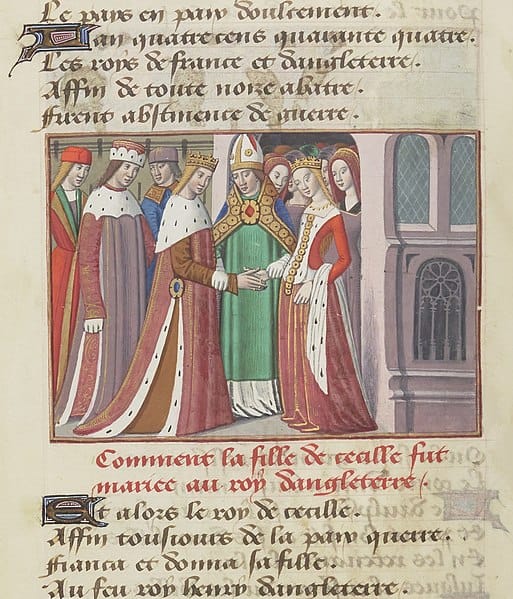
Depiction of the marriage of Henry VI and Margaret of Anjou by Martial d’Auvergne. - In addition, a 23-month truce with France was promised as part of the marriage deal.
- There were differing views on the marriage’s wisdom, but it was generally accepted that it was an honest attempt to bring peace.
- Margaret wed Henry VI of England on 23 April 1445 at Titchfield Abbey in Hampshire. On 30 May 1445, at Westminster Abbey, John Stafford, the Archbishop of Canterbury, crowned her Queen of England. Soon after Margaret’s coronation, René of Anjou began talks with the English monarchy to strike a deal for a lifetime of allyship and a 20-year truce in exchange for Henry’s consent to give up his claim to Anjou and the cession of the English-held area of Maine to Anjou.
- The English populace initially welcomed Margaret with open arms because they believed she would bring about a fresh, enduring peace between England and France.
- However, her popularity did not endure. Despite the English people’s desire for peace, Margaret entered the political discussion over peace terms with France, advocating for surrendering English-held areas in France.
- According to reports, Margaret of Anjou was impulsive and wasteful, recklessly using the Crown’s funds for amusement.
- Her husband disliked her love of hunting, lavish clothes, dancing and other pastimes.
- A sad and devout man, Henry VI had a profound distaste for the types of entertainment Margaret enjoyed.
- After a while, Margaret started openly criticising Richard, Duke of York and Suffolk’s rival, whom she accused of seeking to overthrow her husband so that he could govern. Yet again, she selected a political position opposite the will of the English people. Margaret supported York and believed that Richard might assist England in ending the miseries it endured, including excessive taxation, low international status and a corrupt government bureaucracy.
- York’s popular backing made Richard’s claim a significant threat to Margaret and Henry, for even if Henry acknowledged York as his successor, York might topple Henry before his death.
- Instead of York, Margaret supported Edmund Beaufort, Duke of Somerset, another leading noble who claimed the right to succeed Henry VI but one whom she trusted significantly more.
- For a time between 1450 and 1453, Margaret’s influence prompted Parliament to support Somerset as Henry’s heir-apparent.
- But Margaret was destined to suffer due to her husband’s deteriorating mental state and the whims of the English political scene. Henry VI experienced a mental crisis in August 1453. When Margaret gave birth to a baby, three months later, the truth about his condition became known despite the panicked efforts of Margaret and her advisers to keep it a secret. She gave birth to Edward of Westminster, Prince of Wales. The Duke of York’s threat to the throne would have been removed under different circumstances if an heir had been born, but with Henry incapacitated, York remained just as much of a menace.
DYNASTIC CIVIL WAR
- Soon, fighting broke out between the opposing Yorkist and Lancastrian forces. Just over five months after Richard of York’s protectorate ended, Henry VI recovered from his mental illness. In May 1455, Margaret convened a Great Council from which the Yorkists were banished. To defend the King against his enemies, the Council requested that the peers gather in Leicester. Ready for battle, York soon began moving south to meet the Lancastrian army moving north.
THE WARS OF THE ROSES
- On 22 May 1455, the Lancastrians were defeated at the First Battle of St Albans.
- Lord Edmund Beaufort, the Earl of Northumberland, and Lord Clifford died, and King Henry was captured by the Duke of York, who had won the fight.
- A Yorkist force led by Richard Neville, 5th Earl of Salisbury, defeated James Tuchet, 5th Baron Audley, at the Battle of Blore Heath in 1459, resuming hostilities.
- In a second battle between the Yorkists and Lancastrians, which took place in Northampton in July 1460, the Yorkists emerged triumphant and imprisoned Henry VI and killed many of his fervent adherents. When Margaret learnt of Henry’s defeat, she escaped to the northern counties that supported him.
- Margaret saw how crucial it was for her to stay free with her son: if she and Edward were captured, York would be given a free run.
- King Charles VII of France and Queen Mary of Guelders of Scotland, both of whom wanted to back the victorious side but were unsure which one it would be, only gave hazy promises of support with little concrete evidence and granted her requests for military and financial assistance.
- The future Edward IV of England, the late Richard, Duke of York’s son, defeated the Lancastrian army at the Battle of Towton in March 1461 after overthrowing King Henry and establishing himself as the new king. Margaret went with her son to Wales and later Scotland because she was determined to reclaim her son’s inheritance.
- Finding her way to France, Margaret made her cousin King Louis XI of France, an ally. At his request, she allowed Richard Neville, Earl of Warwick, an ex-supporter of Edward’s who had a falling out with him due to Edward’s marriage to Elizabeth Woodville. She was now seeking vengeance for the loss of his political influence.
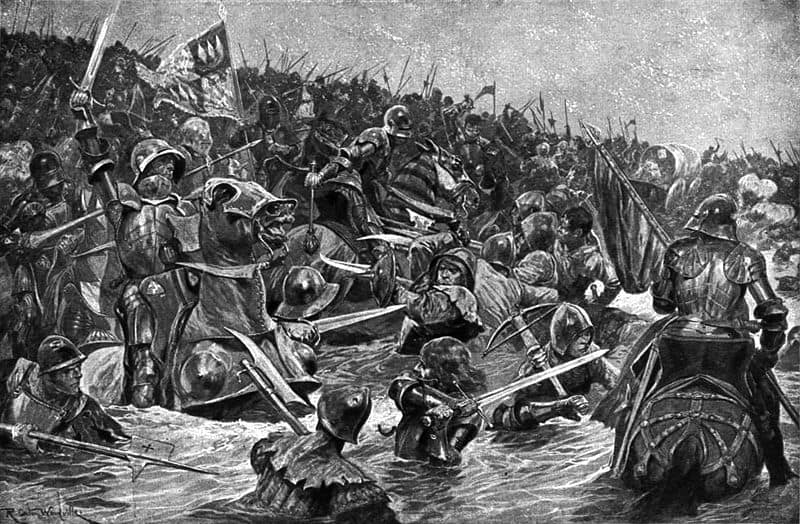
Portrait depicting the Battle of Towton - Warwick’s daughter Anne Neville married Margaret’s son Edward, Prince of Wales, to solidify the alliance. Margaret required that Warwick return to England to establish himself before she followed.
- In October 1470, he succeeded, momentarily installing Henry VI as King.
- The tide had once more reversed in favour of the Yorkists by the time Margaret, her son and daughter-in-law were prepared to follow Warwick back to England, and the Earl was beaten and slain by the returning King Edward IV in the Battle of Barnet in April 1471. At the Battle of Tewkesbury in May 1471, where the Lancastrian forces were routed, and her 17-year-old son Edward of Westminster was murdered, Margaret was compelled to command her army.
- It is unknown if Prince Edward was slain during the actual combat or was put to death by the Duke of Clarence afterwards because the circumstances surrounding his murder were never made explicit.
- Margaret had a reputation for violence and cruelty throughout the preceding ten years, but she was broken-hearted after Tewkesbury and the loss of her only son.
- King Edward’s order imprisoned Margaret after being captured by William Stanley after the fight. She was initially delivered to Wallingford Castle before moving to the safer Tower of London.
- Following Tewkesbury, Henry VI was likewise imprisoned in the Tower, where he passed away on 21 May 1471. The cause of death was uncertain, but regicide – specifically, suffocation in his sleep – was suspected. In 1472, Margaret was given into the care of Alice Chaucer, Duchess of Suffolk, her former lady-in-waiting and remained in her care until Louis XI ransomed her in 1475.
FINAL YEARS
- When Margaret returned to France in 1476, she agreed to pay Louis XI back by giving up all of her inheritance rights to her father’s territories and estates, even though their value was more significant than the sum Louis XI had given her over the years for support and as ransom. Margaret also agreed to renounce any holdings she had in England to Edward IV.
- As a result, Margaret was granted her freedom, but only at the expense of her material belongings.
- However, Louis provided her with a meagre pension to sustain herself.
- She stayed at her ailing father’s court until his passing in 1480. Dispossessed, she then went to Château de Dampierre, René’s private residence, in the Anjou region where she had been raised.
Frequently Asked Questions
- Who was Margaret of Anjou?
Margaret of Anjou was a prominent figure in 15th-century English history. She was the Queen consort of King Henry VI of England and played a pivotal role in the Wars of the Roses. As a staunch Lancastrian, she fought to maintain her husband's and son's claim to the throne.
- Who defeated Margaret of Anjou?
The Yorkist forces defeated Margaret of Anjou during the Wars of the Roses. The critical battle that marked her significant defeat was the Battle of Tewkesbury, which took place on 4 May 1471. In this battle, the Yorkist army, led by Edward IV (son of Richard, Duke of York), defeated Margaret's son, Edward of Lancaster, Prince of Wales.
- What happened to Margaret of Anjou after the Wars of the Roses?
After the Lancastrian defeat at the Battle of Tewkesbury, Margaret of Anjou was captured and taken as a prisoner to the Tower of London, she spent several years in captivity before being released in 1475 through the efforts of Louis XI of France, her father's cousin. Margaret returned to France, where she lived for the remainder of her life until 1482.

